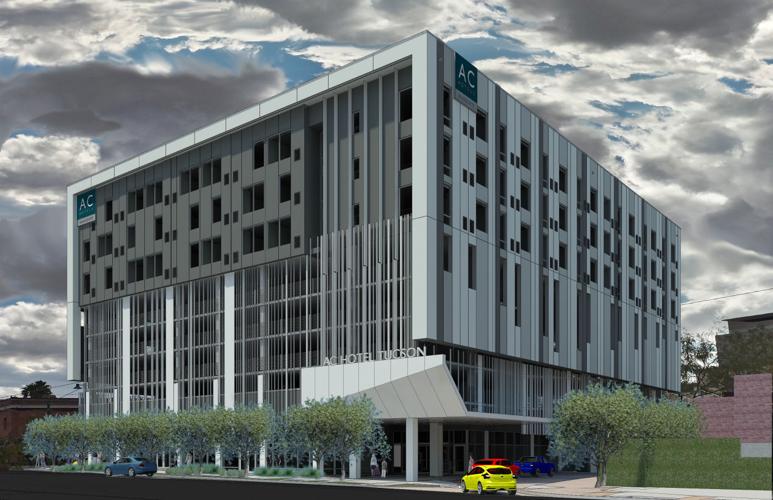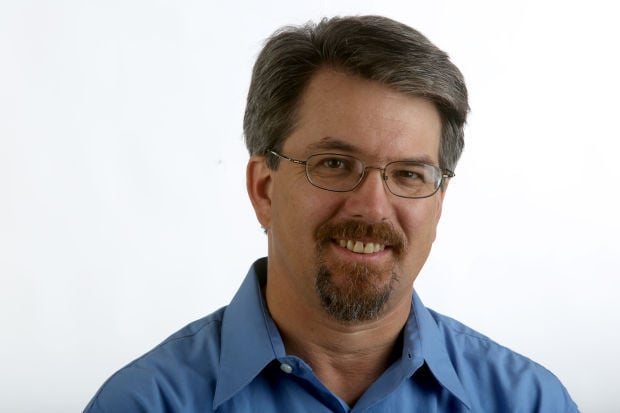I’m not asking for an adobe skyscraper.
That would be an incredibly cool use of local materials, but it just might be structurally unsound.
What I’m requesting is that developers and architects put more thought into local conditions and the human scale as we head into another round of design and building on important new structures in downtown Tucson.
The new Pima County Courthouse, the Tucson Electric Power building and the Cadence apartments show how easy it is to get this wrong. The courthouse, for example, is a concrete monolith that could be built anywhere plopped down amid small old warehouse buildings and the former Rocky Mountain Oyster Club.
Now we have a chance to get it right. Lots of chances, in fact. So let’s make it happen.
Developers have just revealed new renderings of the AC Marriott hotel to be built at Fifth Avenue and Broadway. Plus, new designs are due this week for the possible redevelopment of the part of the Ronstadt Transit Center on East Congress.
Then there are two big housing projects by Holualoa Cos. on South Stone Avenue, the Bourn Cos. project known as The Post on East Congress, and a new round of RFPs for Block 175, the vast parking lot across the street from El Charro on North Church Avenue.
Finally, there’s the large impending development by Allan Norville’s company of a new exhibition center, plus a hotel-apartment-retail-museum complex along Interstate 10 on what is known as the Arena Site.
“Each building will define us for the next two generations,” Michael Keith, CEO of the Downtown Tucson Partnership, told me. “These shouldn’t be light decisions at all. This should be a rigorous debate about who we are and how we’re presenting ourselves.”
Keith argues that the environment these buildings create downtown could be key to our economic future as well. They’ll help decide whether innovative people choose to stay in Tucson or move here from elsewhere.
It’s an intriguing argument. But you don’t have to believe our new buildings will accelerate the local economy to simply wish that they acknowledge our local setting and the fact that 5-foot-6-inch human beings will be walking into, out of and around them.
Architects Miguel Fuentevilla and Sonya Sotinsky, along with developer Scott Stiteler, are trying to balance the competing demands in the new design for the 137-room AC Marriott hotel’s design. The AC hotel line features modern architecture, but of course its setting downtown is an area of older brick buildings, some of which Stiteler has restored.
“Now we have a new building, and that’s a whole different opportunity and challenge,” Stiteler said.
The first floor will be home to the hotel reception area, as well as several retail spaces, he said. Floors two through five will be a parking garage, and floors six through eight will have the hotel rooms.
“There are two different scales. A pedestrian scale and a larger scale because of the size of the building,” Fuentevilla said.
On most of the first two floors, masonry is the dominant material, which reflects somewhat the neighboring brick buildings and “breaks down the scale” of the large building at the pedestrian level, he said.
From the third floor to the eighth, it’s a “vertical pattern of slot windows, joints, stucco and ornamental steel,” Fuentevilla said.
No doubt it’s a modern building, and I’m not sure how it will fit in, but thank goodness the architects are making special efforts to ensure the street level has human-scale details, which isn’t so much the case with other new downtown buildings.
Take the UNS Energy Corp. headquarters at 88 E. Broadway, finished in 2011. The company’s investment in downtown Tucson was a huge boost, and the building is a model of energy efficiency and even rainwater harvesting. But it is an imposing monolith on what was an approachable downtown block.
Twice I’ve eaten outside at the restaurant across South Sixth Avenue that was called Barrio and now is Downtown Kitchen + Cocktails. The first time, years ago, the atmosphere was enchanting. The second time, the imposing wall of the UNS building across the street stole the magic of the place.
Low budgets and procurement rules can lead to buildings that don’t really fit, Tucson architect and historian Bob Vint told me.
“It’s hard to argue with those things, but the whole idea of a regional architecture or local architecture is being swept away,” he said.
He suggested looking at cheaply built structures like the Cadence student-housing complex — at the crucial east entrance to downtown — not as buildings at all.
“It’s basically a commodity. The building is a commodity that is there to extract rent from students,” he said.
And the rent goes to the out-of-state owners who threw up the structures in the first place, Vint said. It’s a pretty depressing way to look at the place but helps explain why that’s the kind of building we have.
Out-of-state architects designed the monolithic new Pima County Courthouse building, too, Vint noted. He compared that building with the Old Pima County Courthouse, the pink, domed building that is perhaps Tucson’s most iconic structure, designed by local architect Roy Place.
“A great Tucson architect like Roy Place probably couldn’t get hired by Pima County to do a courthouse anymore,” he said.
One thing we can hope for out of new buildings is possibly the use of common local materials in the design. Brick is a simple one that was the top building material in downtown a century ago, Vint said. Another regionally significant material is colored concrete, my friend Chris Evans, a Tucson architect, pointed out.
Another factor in regionally representative designs is simple recognition of our climate. East- and west-facing windows should be shaded, for example.
But perhaps most important to me is keeping the street level of these buildings, no matter how big they are, friendly to people walking by.
“An active urban streetscape — that’s what you want in downtown,” Evans said. “Those buildings can contribute to it.”
Or they can detract from it, as we’ve seen.










